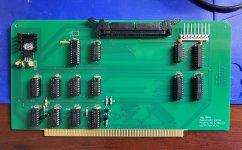Hi,
IF you blow a fuse, you have to remove the whole 9-slot back plane to repair it, with jumper wires, the Mean-Wells take care of everything and it's about impossible to blow them out, they just shut down until the short is fixed.
.
Remember though, while the Meanwell supplies do have overload protection they are not as good as the original analog supplies in other aspects, that people often don't think about.
SMPS supplies specifically designed for computers, if you look at their designs, not only have over-current (overload ) protections, which help to deal with the scenario of shorts, they also have over-voltage protection systems, many are quite elaborate, involving voltage windows and SCR crowbars.
The reason is, in a computer, with a myriad of IC's on a board, an over voltage event is a catastrophic disaster.
For example you might want to look at the design of the IBM-5155 switch mode power supply and the voltage window system they created for the supply outputs. Consider why they did this, it is quite a lot of extra parts.
Or the SOL-20 with an SCR crowbar system on the +5V supply that powered the Mobo.
The Meanwell supplies, which are generic universal SMPS supplies, suited to power a range of appliances, are not specifically intended for computer applications and do not have all these features and failure modes exist in the voltage regulation system where they could potentially over-voltage a computer board, even though they might have good overload/current limiting functions.
Also the old Analog regulators had over-current and over-voltage and thermal protective systems and very rarely, if ever, damage a computer PCB.
So, I'm not saying there is anything wrong with Meanwell supplies, I like them and I use them a lot for various applications, but when it comes to supplying power to vintage computer boards, I either use the original line transformers with Analog regulators or an SMPS supply
specifically intended to power a computer.
But of course, without thinking this through, its easier to grab the quick option. And , like a lot of these things, "most of the time" you will probably get away with it.
If I was building a replica vintage computer, the above would give me two reasons to want to replicate the original power supply system design and keep the analog regulators on the S-100 boards as they were when new.

